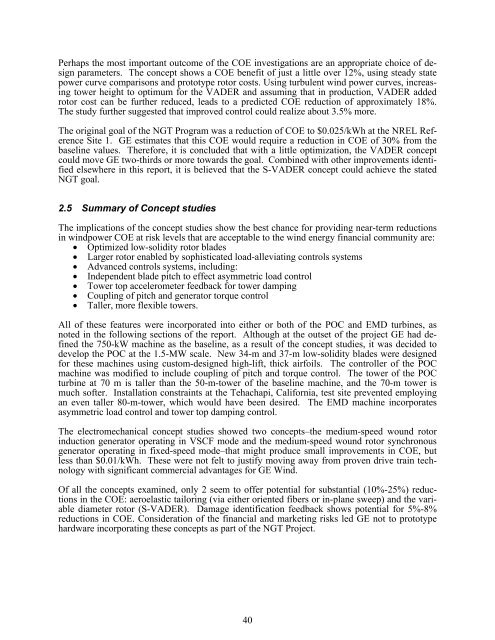Advanced Wind Turbine Program Next Generation Turbine ... - NREL
Advanced Wind Turbine Program Next Generation Turbine ... - NREL
Advanced Wind Turbine Program Next Generation Turbine ... - NREL
Create successful ePaper yourself
Turn your PDF publications into a flip-book with our unique Google optimized e-Paper software.
Perhaps the most important outcome of the COE investigations are an appropriate choice of design<br />
parameters. The concept shows a COE benefit of just a little over 12%, using steady state<br />
power curve comparisons and prototype rotor costs. Using turbulent wind power curves, increasing<br />
tower height to optimum for the VADER and assuming that in production, VADER added<br />
rotor cost can be further reduced, leads to a predicted COE reduction of approximately 18%.<br />
The study further suggested that improved control could realize about 3.5% more.<br />
The original goal of the NGT <strong>Program</strong> was a reduction of COE to $0.025/kWh at the <strong>NREL</strong> Reference<br />
Site 1. GE estimates that this COE would require a reduction in COE of 30% from the<br />
baseline values. Therefore, it is concluded that with a little optimization, the VADER concept<br />
could move GE two-thirds or more towards the goal. Combined with other improvements identified<br />
elsewhere in this report, it is believed that the S-VADER concept could achieve the stated<br />
NGT goal.<br />
2.5 Summary of Concept studies<br />
The implications of the concept studies show the best chance for providing near-term reductions<br />
in windpower COE at risk levels that are acceptable to the wind energy financial community are:<br />
• Optimized low-solidity rotor blades<br />
• Larger rotor enabled by sophisticated load-alleviating controls systems<br />
• <strong>Advanced</strong> controls systems, including:<br />
• Independent blade pitch to effect asymmetric load control<br />
• Tower top accelerometer feedback for tower damping<br />
• Coupling of pitch and generator torque control<br />
• Taller, more flexible towers.<br />
All of these features were incorporated into either or both of the POC and EMD turbines, as<br />
noted in the following sections of the report. Although at the outset of the project GE had defined<br />
the 750-kW machine as the baseline, as a result of the concept studies, it was decided to<br />
develop the POC at the 1.5-MW scale. New 34-m and 37-m low-solidity blades were designed<br />
for these machines using custom-designed high-lift, thick airfoils. The controller of the POC<br />
machine was modified to include coupling of pitch and torque control. The tower of the POC<br />
turbine at 70 m is taller than the 50-m-tower of the baseline machine, and the 70-m tower is<br />
much softer. Installation constraints at the Tehachapi, California, test site prevented employing<br />
an even taller 80-m-tower, which would have been desired. The EMD machine incorporates<br />
asymmetric load control and tower top damping control.<br />
The electromechanical concept studies showed two concepts–the medium-speed wound rotor<br />
induction generator operating in VSCF mode and the medium-speed wound rotor synchronous<br />
generator operating in fixed-speed mode–that might produce small improvements in COE, but<br />
less than $0.01/kWh. These were not felt to justify moving away from proven drive train technology<br />
with significant commercial advantages for GE <strong>Wind</strong>.<br />
Of all the concepts examined, only 2 seem to offer potential for substantial (10%-25%) reductions<br />
in the COE: aeroelastic tailoring (via either oriented fibers or in-plane sweep) and the variable<br />
diameter rotor (S-VADER). Damage identification feedback shows potential for 5%-8%<br />
reductions in COE. Consideration of the financial and marketing risks led GE not to prototype<br />
hardware incorporating these concepts as part of the NGT Project.<br />
40
















